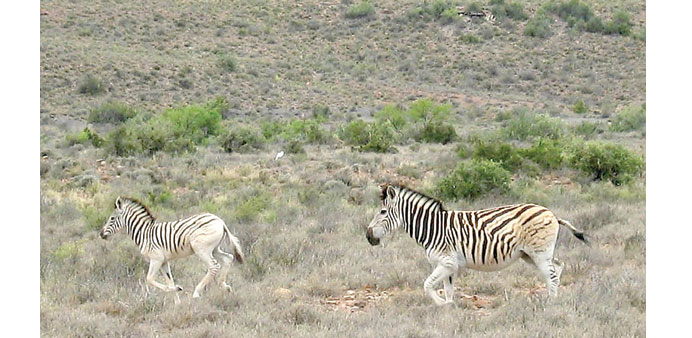By Ralf E. Krueger
The quagga — a zebra whose stripes appear to have washed off in the rain — roamed the South African plains up to the end of the 17th century, but European settlers saw them as competition for scarce grazing land and wiped them out.
The last quagga died in Amsterdam’s zoo in 1883, making the species extinct. That was until zoologist discovered that the quagga’s DNA was very similar to that of Burchell’s zebra, a subspecies of the plains zebra.
A project has been under way since 1987 which claims it can breed the quagga back through selective crossing of zebras showing quagga characteristics.
While many are fascinated by the idea, there has also been considerable debate about the validity of this genetic tinkering — and its usefulness, but it has now made considerable progress and reaches a major milepost.
“The project is on course, but we are not at our goal,” says Angela Gaylard, an ecologist with the South African National Parks (SANParks).
“It’s an ongoing process and so it’s difficult to say whether we already have a quagga. But after four generations we have up to 12 quagga-like animals, although they lack the dark brown colour to some extent.”
That colour is now starting to come through, and the fifth generation born last December is likely to be decisive for the project’s success — exactly as the project’s German-born initiator, Reinhold Rau, once predicted.
Gaylard is convinced that Rau, who died in 2006, was “correct with his hypothesis on all points.”
There is already some evidence of the brown colour.
“We are going to discuss strategy and advertise the fact that we have a fifth-generation foal after our annual general meeting at the end of August,” said project manager Bernard Wooding.
“It’s a female that we have called Frederica.” He said the announcement of the December birth was delayed because foals are vulnerable in their first six months.
Photographs of the foal, born in the Nuwejaars Wetland Special Management Area near Bredasdorp, close to Africa’s most southern tip, show a brown colour, along with the stripes occurring only on the forequarters — a characteristic typical of the quagga.
Some 27 years after the start of the project there are now 89 quagga-like animals scattered over various game farms and national parks.
SANParks has withdrawn from the project on grounds of cost, leaving a single representative on the project committee. It is instead focussing its declining budget on combating the rhinoceros poaching that increasingly bedevils South Africa’s parks.
But it also has doubts of a more fundamental nature. There is now a risk of interbreeding between zebra subspecies, particularly in the Mountain Zebra National Park.
“We have photographs of hybrids of Cape mountain zebras and the quagga-like animals, and we can’t take a chance on this. We must maintain the purity of the mountain zebra gene pool,” Gaylard says.
This particular national park was created primarily to save the threatened subspecies. “We have decided to take the quaggas out of the Mountain Zebra National Park, and in future also out of the Karoo National Park,” she says.
They will be relocated to farms.
Zoologists have long viewed the project with some scepticism. “I see the whole thing from a scientific point of view as not really necessary,” says Dan Parker, professor in the Department of Zoology at Rhodes University in Grahamstown.
“There is this romantic idea that we should bring back the quagga to the world because we were involved in eliminating it — that we should correct that,” Parker says.
Critics say a species is defined by its complete genome in all its complexity, not by its coat, so the new animals will not be true quaggas. Despite his general scepticism, he acknowledges that he is
awaiting the fifth generation and what it will look like with anticipation.
And even if the animals merely look like quaggas, there will be considerable potential for tourism, Parker believes. “People will probably pay a lot of money to see something like that,” he says.
The question remains what to call these animals. Wooding has a solution to the problem.
“We call the quagga-like animals ‘Rau’s Quagga’,” he says. -DPA

